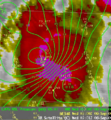Squall facts for kids

Imagine the wind suddenly getting much stronger! That's a squall. It's a quick, big jump in wind speed that lasts for a few minutes. This is different from a wind gust, which only lasts for a few seconds. Squalls often happen when there's active weather nearby. This can include rain showers, thunderstorms, or even heavy snow. During a squall, the wind stays strong for a while. There might even be stronger, shorter gusts within that time. Squalls usually form when cool air sinks quickly in the middle of the atmosphere. This sinking air pushes other air upwards, creating strong winds.
Contents
What Causes a Squall?
Squalls are caused by specific weather conditions. They happen when cold air rushes down from the sky. This cold air spreads out when it hits the ground. It pushes the warmer air up and away. This creates a sudden burst of strong wind.
How Air Movement Creates Squalls
When air cools high up, it becomes heavier. This heavy air then starts to fall very fast. As it falls, it creates a strong downward push. When this air hits the ground, it spreads out quickly. This spreading air is what we feel as a squall.
The Role of Thunderstorms
Thunderstorms are a common cause of squalls. Inside a thunderstorm, there are strong updrafts and downdrafts. Updrafts pull warm, moist air upwards. Downdrafts push cold air downwards. It's these strong downdrafts that lead to squalls. The cold air rushing down from the storm cloud creates the sudden strong winds.
Types of Squalls
Not all squalls are the same. They can happen in different weather situations. Knowing the type helps us understand them better.
Line Squalls
A line squall is a long line of thunderstorms. These storms often form along a cold front. As the cold front moves, it pushes warm air up. This creates a line of strong storms. The winds from these storms can create a very wide squall. They can affect a large area as they pass.
Snow Squalls
Snow squalls are like quick, intense snowstorms. They bring sudden, heavy snowfall. This can reduce visibility very quickly. Snow squalls are often linked to strong winds. They can make driving conditions very dangerous. They usually last for a short time, maybe 30 to 60 minutes.
Lake-Effect Snow Squalls
In areas near large lakes, snow squalls can be common. Cold air moves over warmer lake water. This picks up moisture and forms snow clouds. These clouds then drop heavy snow in narrow bands. This is called "lake-effect" snow. The strong winds with these squalls can make conditions even worse.
How Squalls Affect Us
Squalls can have a big impact. They can be dangerous for people and property.
Safety During a Squall
When a squall hits, it's important to be safe. Strong winds can break tree branches. They can also blow around loose objects. If you are outside, seek shelter. If you are driving, be extra careful. Visibility can drop quickly, especially with snow squalls.
Impact on Travel
Squalls can make travel difficult. For airplanes, strong winds can cause turbulence. For boats, squalls can create rough waves. They can also make it hard to steer. Drivers on roads might face sudden low visibility. This is especially true during snow or rain squalls.
Images for kids
See also
 In Spanish: Turbonada para niños
In Spanish: Turbonada para niños




